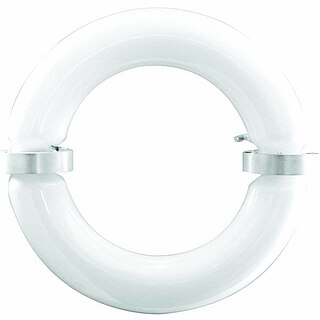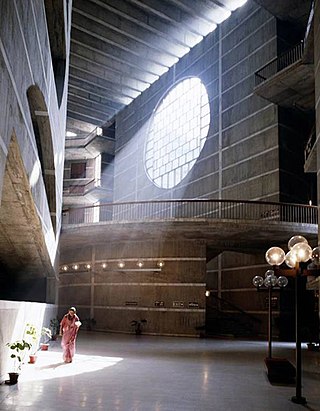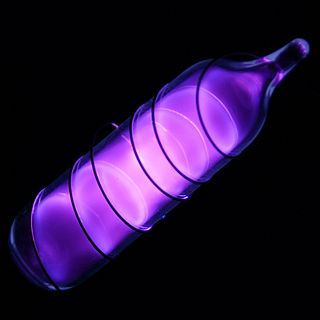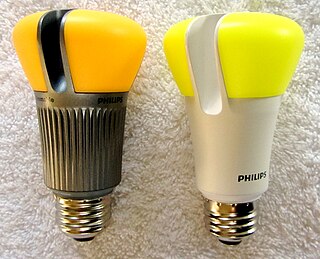
An electric light, lamp, or light bulb is an electrical component that produces light. It is the most common form of artificial lighting. Lamps usually have a base made of ceramic, metal, glass, or plastic which secures the lamp in the socket of a light fixture, which is often called a "lamp" as well. The electrical connection to the socket may be made with a screw-thread base, two metal pins, two metal caps or a bayonet mount.

An incandescent light bulb, incandescent lamp or incandescent light globe is an electric light with a filament that is heated until it glows. The filament is enclosed in a glass bulb that is either evacuated or filled with inert gas to protect the filament from oxidation. Electric current is supplied to the filament by terminals or wires embedded in the glass. A bulb socket provides mechanical support and electrical connections.

Lighting or illumination is the deliberate use of light to achieve practical or aesthetic effects. Lighting includes the use of both artificial light sources like lamps and light fixtures, as well as natural illumination by capturing daylight. Daylighting is sometimes used as the main source of light during daytime in buildings. This can save energy in place of using artificial lighting, which represents a major component of energy consumption in buildings. Proper lighting can enhance task performance, improve the appearance of an area, or have positive psychological effects on occupants.

Photometry is a branch of optics that deals with measuring light in terms of its perceived brightness to the human eye. It is concerned with quantifying the amount of light that is emitted, transmitted, or received by an object or a system.

A mercury-vapor lamp is a gas-discharge lamp that uses an electric arc through vaporized mercury to produce light. The arc discharge is generally confined to a small fused quartz arc tube mounted within a larger soda lime or borosilicate glass bulb. The outer bulb may be clear or coated with a phosphor; in either case, the outer bulb provides thermal insulation, protection from the ultraviolet radiation the light produces, and a convenient mounting for the fused quartz arc tube.

The lumen is the unit of luminous flux, a measure of the perceived power of visible light emitted by a source, in the International System of Units (SI). Luminous flux differs from power in that radiant flux includes all electromagnetic waves emitted, while luminous flux is weighted according to a model of the human eye's sensitivity to various wavelengths; this weighting is standardized by the CIE and ISO. One lux is one lumen per square metre.

A compact fluorescent lamp (CFL), also called compact fluorescent light, energy-saving light and compact fluorescent tube, is a fluorescent lamp designed to replace an incandescent light bulb; some types fit into light fixtures designed for incandescent bulbs. The lamps use a tube that is curved or folded to fit into the space of an incandescent bulb, and a compact electronic ballast in the base of the lamp.

The history of street lighting in the United States is closely linked to the urbanization of America. Artificial illumination has stimulated commercial activity at night, and has been tied to the country's economic development, including major innovations in transportation, particularly the growth in automobile use. In the two and a half centuries before LED lighting emerged as the new "gold standard", cities and towns across America relied on oil, coal gas, carbon arc, incandescent, and high-intensity gas discharge lamps for street lighting.

An emergency light is a battery-backed lighting device that switches on automatically when a building experiences a power outage.

The induction lamp, electrodeless lamp, or electrodeless induction lamp is a gas-discharge lamp in which an electric or magnetic field transfers the power required to generate light from outside the lamp envelope to the gas inside. This is in contrast to a typical gas discharge lamp that uses internal electrodes connected to the power supply by conductors that pass through the lamp envelope. Eliminating the internal electrodes provides two advantages:
Luminous efficacy is a measure of how well a light source produces visible light. It is the ratio of luminous flux to power, measured in lumens per watt in the International System of Units (SI). Depending on context, the power can be either the radiant flux of the source's output, or it can be the total power consumed by the source. Which sense of the term is intended must usually be inferred from the context, and is sometimes unclear. The former sense is sometimes called luminous efficacy of radiation, and the latter luminous efficacy of a light source or overall luminous efficacy.

Architectural lighting design is a field of work or study that is concerned with the design of lighting systems within the built environment, both interior and exterior. It can include manipulation and design of both daylight and electric light or both, to serve human needs.

The sulfur lamp is a highly efficient full-spectrum electrodeless lighting system whose light is generated by sulfur plasma that has been excited by microwave radiation. They are a particular type of plasma lamp, and one of the most modern. The technology was developed in the early 1990s and appeared promising, but was not a commercial success by the late 1990s. Since 2005, lamps are again being manufactured for commercial use.

A light fixture, light fitting, or luminaire is an electrical lighting device containing one or more light sources, such as lamps, and all the accessory components required for its operation to provide illumination to the environment. All light fixtures have a fixture body and one or more lamps. The lamps may be in sockets for easy replacement—or, in the case of some LED fixtures, hard-wired in place.

An LED lamp or LED light is an electric light that produces light using light-emitting diodes (LEDs). LED lamps are significantly more energy-efficient than equivalent incandescent lamps and fluorescent lamps. The most efficient commercially available LED lamps have efficiencies exceeding 200 lumens per watt (lm/W) and convert more than half the input power into light. Commercial LED lamps have a lifespan several times longer than both incandescent and fluorescent lamps.

Various governments have passed legislation to phase out manufacturing or importation of incandescent light bulbs for general lighting in favor of more energy-efficient alternatives. The regulations are generally based on efficiency, rather than use of incandescent technology.

Plasma lamps are a type of electrodeless gas-discharge lamp energized by radio frequency (RF) power. They are distinct from the novelty plasma lamps that were popular in the 1980s.
United States Lighting Energy Policy is moving towards increased efficiency in order to lower greenhouse gas emissions and energy use. Lighting efficiency improvements in the United States can be seen through different standards and acts. The Energy Independence and Security Act of 2007 laid out changes in lighting legislation for the United States. This set up performance standards and the phase-out of incandescent light bulbs in order to require the use of more efficient fluorescent lighting. EISA 2007 is an effort to increase lighting efficiency by 25-30%. Opposition to EISA 2007 is demonstrated by the Better Use of Light Bulbs Act and the Light Bulb Freedom of Choice Act. The efforts to increase lighting efficiency are also demonstrated by the Energy Star program and the increase efficiency goals by 2011 and 2013. A ban on the manufacture and sale of most general purpose incandescent bulbs in the U.S. took effect on August 1, 2023.

Plumen is a designer low energy lighting company based in London, UK. The Plumen 001, their debut product, is a designer low energy compact fluorescent light. The design of the Plumen 001 lightbulb is result of collaboration between the Hulger team and designer Samuel Wilkinson. A prototype of the Plumen 001 has been added to MOMA permanent design collection, and has won Brit Insurance Design Awards 2011.

High-CRI LED lighting is a light-emitting diode (LED) lighting source that offers a high color rendering index (CRI).



















